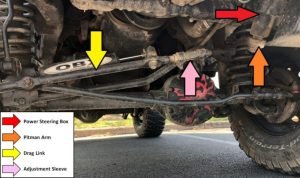Coilovers are an essential part of a car’s suspension system. They provide a smooth and comfortable ride by absorbing the shocks and bumps on the road. However, they are only effective if they are adjusted correctly. Adjusting your coilovers can be a daunting task, but it is essential if you want to achieve the best performance from your vehicle.
In this blog post, we will cover everything you need to know about adjusting coilovers. Whether you’re a seasoned car enthusiast or a beginner, we will provide you with the necessary knowledge to make the adjustments yourself. We will start by explaining the basics of coilovers, including their functionality, types, and components. Then, we will walk you through the process of adjusting coilovers step by step. We will provide you with tips and tricks to help you get the most out of your adjustments and avoid common mistakes.
Finally, we will discuss situations where it may be necessary to seek professional help. By the end of this article, you will have a good understanding of how to adjust coilovers like a pro, and you will be able to enjoy the best possible driving experience. So, let’s get started!
Contents
Understanding the Basics of Coilovers
Coilovers are a type of suspension system that combines a shock absorber and a spring into a single unit. The shock absorber controls the movement of the spring and keeps it from bouncing uncontrollably. Meanwhile, the spring absorbs the shocks from the road and keeps the car level.
A. Functionality
Coilovers have two main functions: controlling the ride height and controlling the dampening. The ride height refers to the distance between the ground and the car’s chassis. Adjusting the ride height can improve the car’s handling and appearance. Meanwhile, dampening refers to the resistance of the shock absorber to movement. Adjusting the dampening can improve the car’s comfort, handling, and stability.
B. Types of Coilovers
There are two main types of coilovers: full coilovers and sleeve coilovers. Full coilovers come with a complete shock absorber and spring assembly and are designed to be a direct replacement for your factory suspension. Sleeve coilovers, on the other hand, are designed to work with your factory shock absorber, with a threaded sleeve that slides over the shock absorber and allows you to adjust the ride height.
C. Components of Coilovers
Coilovers consist of several components, including the shock absorber, spring, top mount, bottom mount, and adjustment knobs. The shock absorber is the heart of the coilover and controls the movement of the spring. The spring is responsible for absorbing the shocks and keeping the car level. The top mount and bottom mount connect the coilover to the car’s chassis and suspension. Finally, the adjustment knobs allow you to adjust the ride height and dampening of the coilover.
Understanding the basics of coilovers is crucial to make the necessary adjustments. In the next section, we will discuss the step-by-step process of adjusting coilovers.
The Process of Adjusting Coilovers
Adjusting coilovers is a process that requires careful attention and precision. It’s important to note that the adjustment process may vary depending on the type of coilovers you have installed on your car. In this section, we will provide a general guide to adjusting coilovers that should work for most types.
A. Preparing for the Adjustment Process
Before you start adjusting your coilovers, you need to make sure that you have the necessary tools and equipment. You will need a jack, jack stands, wrenches, and pliers. Additionally, it’s important to take safety precautions to avoid injury. Make sure that your car is on a level surface and that the emergency brake is engaged. Also, wear protective gear such as gloves and eye protection.
B. The Adjustment Process
Adjusting Ride Height
The first step in adjusting your coilovers is to adjust the ride height. To do this, you will need to raise the car with a jack and secure it with jack stands. Locate the adjustment knob on the coilover, which is usually located on the top mount. Turn the knob clockwise to lower the car and counterclockwise to raise it. It’s important to make sure that the ride height is adjusted evenly on both sides of the car to avoid uneven wear on the tires.
Adjusting Damping
The next step is to adjust the damping, which controls the resistance of the shock absorber to movement. Locate the adjustment knob for the damping, which is usually located on the bottom mount. Turning the knob clockwise increases the damping, while turning it counterclockwise decreases it. It’s important to find the right balance between comfort and handling. Adjusting the damping too much can make the car too stiff, while too little can make it too bouncy.
Adjusting Spring Preload
Finally, you may need to adjust the spring preload, which refers to the amount of compression on the spring when the car is at rest. To adjust the preload, locate the adjustment collar on the coilover. Turning the collar clockwise increases the preload, while turning it counterclockwise decreases it. It’s important to make sure that the preload is adjusted evenly on both sides of the car to avoid uneven ride height.
Tips for Adjusting Coilovers
Adjusting coilovers requires experimentation and patience. Here are some tips to help you get the most out of your adjustments:
A. Experimentation is key: Try different settings to find the right balance between comfort and handling.
B. Start with small adjustments: Make small adjustments at a time to avoid making drastic changes that could harm your car’s performance.
C. Keep track of adjustments: Take notes on the adjustments you make, so you can keep track of what works and what doesn’t.
D. Test the adjustments: Take your car for a test drive to see how it feels. If the ride feels uncomfortable or unstable, make further adjustments.
Common Mistakes to Avoid When Adjusting Coilovers
Adjusting coilovers can be tricky, and it’s important to avoid making common mistakes such as:
A. Adjusting too quickly: Making large adjustments at once can lead to drastic changes in the car’s handling and ride comfort.
B. Neglecting safety precautions: Make sure to follow proper safety procedures to avoid injury.
C. Failing to keep track of adjustments: Without keeping track of your adjustments, it can be challenging to find the right balance between comfort and handling.
When to Seek Professional Help
Adjusting coilovers is a delicate process, and it’s important to know when to seek professional help. Here are some situations where it may be necessary to consult a professional:
A. Complex coilover issues: If you’re experiencing complex problems with your coilovers, such as leaks or damaged components, it’s best to consult a professional to avoid causing further damage.
B. Lack of experience: If you’re not familiar with adjusting coilovers, it may be best to seek professional help to avoid making mistakes that could harm your car’s performance.
C. Warranty concerns: If your coilovers are still under warranty, it’s important to check if adjusting them yourself will void the warranty. If so, it may be best to have a professional adjust them.
FAQ:
Q: Can I adjust coilovers without lifting my car?
A: No, you will need to raise your car with a jack and secure it with jack stands before you can adjust the coilovers.
Q: How often should I adjust my coilovers?
A: The frequency of adjusting your coilovers depends on your driving habits and personal preference. It’s recommended to make small adjustments and test drive your car before making further changes.
Q: Will adjusting coilovers affect my car’s alignment?
A: Yes, adjusting the ride height can affect your car’s alignment. It’s recommended to have a professional check and adjust the alignment after adjusting the coilovers.
Q: Can I adjust the damping and preload without adjusting the ride height?
A: Yes, you can adjust the damping and preload without adjusting the ride height. However, it’s important to keep in mind that adjusting the damping and preload can affect the ride height.
Q: What are the benefits of adjusting coilovers?
A: Adjusting coilovers can improve your car’s handling, performance, and ride comfort. It can also provide a more customizable driving experience.
Q: Can I adjust coilovers myself, or do I need to go to a professional?
A: Adjusting coilovers requires attention to detail and precision, but it can be done by a car enthusiast with the right tools and knowledge. However, if you’re not experienced or comfortable with adjusting coilovers, it’s recommended to seek professional help.
Conclusion
In conclusion, adjusting coilovers is a process that requires attention to detail and precision. Understanding the basics of coilovers, the process of adjusting them, and the common mistakes to avoid can help you get the most out of your car’s performance. Experimentation and patience are key, but it’s also important to seek professional help in certain situations to avoid causing further damage. With these tips in mind, you can confidently adjust your coilovers like an automotive expert.
Affiliate Disclosure: As an Amazon Associate, I earn from qualifying purchases made through links on this site.






